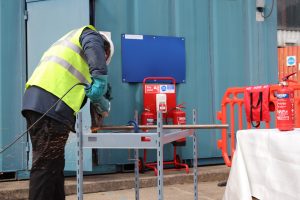Recently added item(s)
You have no items in your basket.

In part one of this two-part blog, we looked at the fire risks on construction sites and how best to detect and warn the workforce of a fire. In this second part we look at the best means of fighting a fire should one break out on site.
Prompt action can stop a small fire becoming a big one and for decades statistics have consistently shown most fires are effectively dealt with by first aid firefighting.
Suitable extinguishers should be located around the site, with general protection to each level on exit routes but with a specific focus on areas of high risk including where hot work is carried out, plant and machinery is running and increasingly where battery operated equipment is charged.
Water extinguishers are great for fires in ordinary combustibles such as wood, paper, textiles etc. However, they are limited by being unsuitable for electrical equipment and flammable liquids, although their cooling action is useful as a deep-seated fire could possibly reignite if initially extinguished by means other than thoroughly soaking through. Water with additive extinguishers are even more effective at soaking and cooling.
Water Mist takes the normal water extinguisher to a new dimension. Still effective on ordinary combustibles the water mist extinguisher is safe on electrical fires, cooking oil fires and can also deal with small surface flammable liquid fires too. It’s clean and relatively non damaging due to the fine mist.
Foam extinguishers retain the cooling ability of plain water along with the capability to extinguish flammable liquid fires or even prevent them – the foam blanket on a spilt flammable liquid will prevent ignition or re-ignition. Most can be used near electrical equipment safely.
Carbon Dioxide is popular for electrical equipment and enclosed items of plant as the gas can readily flood the housing to extinguish the fire by smothering. It is also effective on small liquid fires. However, if a site is still relatively open-air care needs to be taken as carbon dioxide is easily dispersed and wind/air currents can reduce the effectiveness of the agent. It should be avoided in very confined spaces too in case it affects the operator
ABC Dry Powder is popular on construction sites as it is frost proof (unlike water-based extinguishers) and is multipurpose being suitable for all normal classes of fire other than cooking oils. Whilst an assessment of the risk from the clouds of fine powder should be carried out due to the effects on vision and when inhaled as well as a consideration of the secondary damage, it remains a good choice due to the high firefighting power and all-round cover of powder compared to other agents. As it works primarily by chemical inhibition there is a reignition risk on solids and liquids, so powder extinguishers are often still combined with water or foam as a back-up.
Wet chemical extinguishers are primarily for cooking oil fires and are generally not appropriate for construction sites unless there is an onsite restaurant/kitchen using cooking oils.
Lithium-ion batteries are an increasing risk. With more fires reported in equipment using these and site tools being increasingly battery powered this is now a risk a site cannot overlook. These risks can be covered by special agents such as AVD – a vermiculite-based solution that encapsulates and insulates cells in addition to cooling – which is available in a range of portable and wheeled extinguishers. Special fire blankets for larger equipment are also available.
Fire blankets are useful items not just for small pans of cooking oil but any type of contained fire small enough for the blanket to cover. The larger blankets are also ideal for clothing fires and can be used to protect combustible items which are near to hot work that can’t be easily moved.
Whatever your choice of extinguisher, they must be readily available and not hidden or randomly dotted about. The use of fire point stands, and trolleys is an important way to keep equipment readily available and visible. The larger ‘site-point’ fire points can also combine extinguishers with fire instruction signage, plans, alarm points and more!
Extinguishers also require regular servicing, both on first installation and at least annually (or more often as site equipment often has a higher rate of wear and tear) plus regular inspections – all too often extinguishers are found damaged, empty, or depressurised. Powder extinguishers are particularly vulnerable as if discharged for even a fraction of a second, will soon lose remaining operating pressure as the powder stops the control valve fully seating so the extinguisher may feel full, but won’t discharge.
Fire Depot has been the UK's favourite fire safety supplier for over 50 years, we know the fire protection and prevention business inside out. Our experienced team can offer advice and guidance about any of our fire safety products. For expert help and advice, please contact the Fire Depot team on 0330 999 2233, email us at sales@firedepot.co.uk or visit https://www.firedepot.co.uk/ to see our full range of fire safety products.
The information contained within this blog is provided solely for general informational and educational purposes and is not intended as a substitute for professional advice. Before taking any actions based upon this information, we advise the reader to consult any and all relevant statutory or regulatory guidance and where felt necessary to consult a qualified fire or industry regulation professional. The use or reliance on any information contained herein is solely at the reader’s risk.